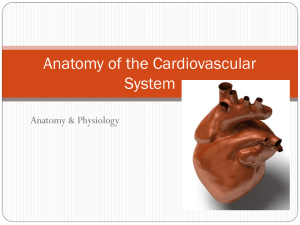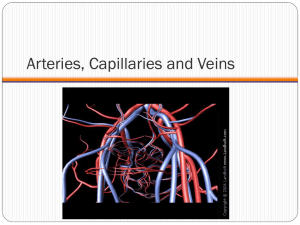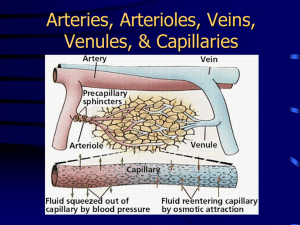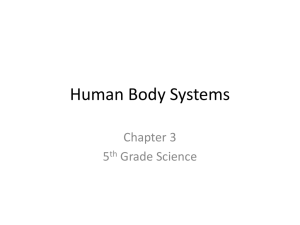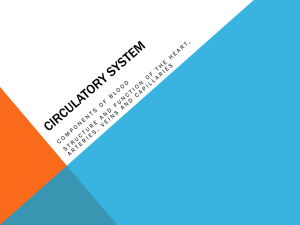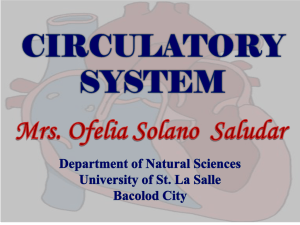Chapter 18/Anatomy of blood vessels
advertisement
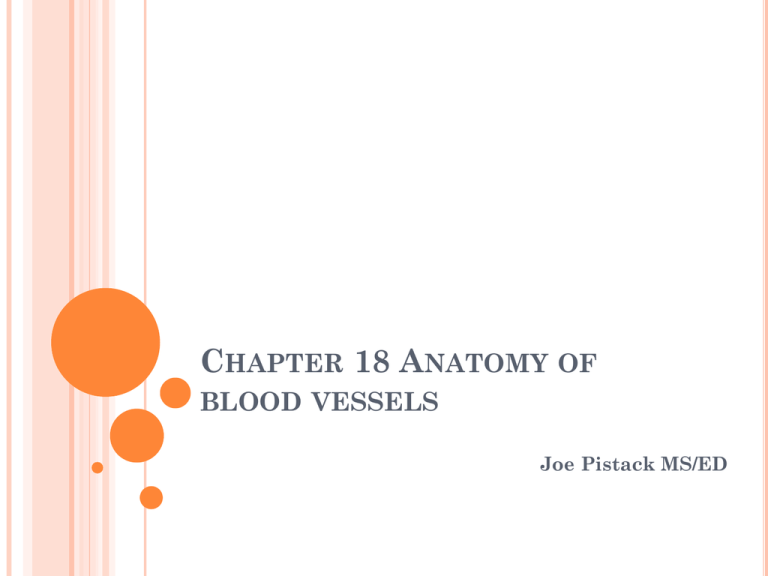
CHAPTER 18 ANATOMY OF BLOOD VESSELS Joe Pistack MS/ED CIRCULATORY SYSTEM Circulatory System consists of the heart and blood vessels. The blood vessels are a series of connected, hollow tubes that begin and end in the heart. PULMONARY CIRCULATION Carries blood from the right ventricle of the heart to the lungs and back to the left atrium of the heart. Pulmonary circulation transports unoxygenated blood to the lungs, where oxygen is loaded and carbon dioxide is unloaded. SYSTEMIC CIRCULATION The larger circulation. Blood vessels are arteries, capillaries, and veins. Provides the blood supply to the rest of the body. Carries oxygen and other nutrients to the cells and picks up carbon dioxide and other waste. BLOOD VESSELS Highway of the body. Classified as: Arteries Capillaries Veins Blood vessels are composed of three layers except for capillaries. ARTERIES Called conductance vessels, carry blood away from the heart. Thick wall with three layers: 1 - Tunica intima- innermost layer, continuous with the endocardium, blood flows easily here. ARTERIES 2 - Tunica mediamiddle layer, thickest layer, composed of elastic tissue and smooth muscle. Made up of elastic tissue and smooth muscle, capable of stretching in response to the pumping of blood by the heart. ARTERIES 3 -Tunica adventitiathe outer layer, composed of tough connective tissue, function is to support and protect. Arterioles-the smallest artery, numerous and branch out. CAPILLARIES Smallest and most numerous of all blood vessels. Close to every cell, numerous, provide the cells with oxygen and nutrients. ARTERIOLES Smallest of the arteries. Composed of smooth muscle that contract and relax. Called resistance vessels able to change their size which alters the pressure in the blood to less resistance when dilated and more resistance when constricted. CAPILLARIES Have the thinnest walls of all blood vessels. Single layer epithelium on a delicate basement membrane. Called exchange vessels - allow the exchange of nutrients, gases and waste. VEINS Blood vessels that carry blood back to the heart. Smallest veins are called venules. The largest veins empty the blood into the right atrium of the heart. VENULES Converge from capillaries. Wall of venule is slightly thicker than capillary wall. Pressure in veins is less than pressure in the arteries. VEINS Most veins contain one-way valves which direct the flow of blood toward the heart. Called capacitance vessels, store about 70% of our blood volume. When stored blood is needed, the veins constrict and move blood to the heart for circulation. MAJOR ARTERIES OF SYSTEMIC CIRCULATION Aorta Largest of all arteries. Average diameter of a garden hose. Originates in the left ventricle of the heart, curves in an archlike fashion and descends through the thorax. AORTA The aorta ends in the pelvic cavity where it splits into two common iliac arteries. The aorta is divided into segments, each named according to two systems. AORTA System I, path that the aorta follows as it courses through the body. 1. 2. 3. Ascending aorta Arch of the aorta Descending aorta AORTA System II, path named according to location within the body cavities. 1. thoracic aorta 2. abdominal aorta AORTA Arteries arise directly from the aorta or from vessels that are branches of the aorta. The ascending aorta arises from the left ventricle, begins at the aortic semilunar valve and extends to the aortic arch. AORTA Right and left coronary arteries branch from the ascending aorta. Coronary arteries are distributed throughout the heart and supply oxygenated blood to the myocardium. BRANCHES OF THE AORTIC ARCH The aortic arch extends from the ascending aorta to the beginning of the descending aorta. Three large arteries arise from the aortic arch: 1. brachiocephalic arterysupplies blood to the right side of the head, neck, right shoulder, and right upper extremity. BRANCHES OF THE DESCENDING AORTA (Thoracic aorta) Upper portion of the descending aorta. It extends from the aortic arch to the diaphragm. Intercostal arteries arise from the aorta and supply the intercostal muscles between the ribs. BRANCHES OF THE AORTIC ARCH 2. Left common carotid arteryextends upward from the highest point of the aortic arch and supplies the left side of the head and neck. 3. Left & right subclavian arteries supply blood to the shoulders and upper arms. BRANCHES OF THE DESCENDING AORTA (Abdominal aorta) Extends from the thoracic aorta to the lower abdomen. Branches include: 1. celiac trunk-short artery that divides into the gastric artery, splenic artery, and hepatic artery. BRANCHES OF THE DESCENDING AORTA 2. Two mesenteric arteries are the: 1. superior mesenteric artery-supplies most of the small intestine and part of the large intestine. 2. inferior mesenteric artery - supplies the rest of the large intestine. BRANCHES OF THE DESCENDING AORTA 3. 3. Renal arteriessupply blood to the right and left kidneys. 4. 4. The common iliac arteries-supply the pelvic organs, thigh, and lower extremities. VEINS OF THE SYSTEMIC CIRCULATION Superficial veins-located superficially and can be seen. Deep veins-located more deeply and usually run parallel to the arteries. The names of the deep veins are the same name as the companion artery, with few exceptions. Ex. Femoral artery is accompanied by the femoral vein. VENAE CAVAE Veins carry blood from all parts of the body to the venae cava for delivery to the heart. The venae cava is the main vein. Divided into the superior vena cava (SVC) and the inferior vena cava. SUPERIOR VENAE CAVA Veins draining blood from the head, the shoulders, and the upper extremities empty into the SVC. Veins may drain directly or indirectly. SUPERIOR VENA CAVA Veins that empty into the SVC: The cephalic vein The basilic vein Subclavian veins External jugular veins Internal jugular veins Brachiocephalic veins Azygos vein INFERIOR VENA CAVA IVC returns blood to the heart from all regions of the body. Veins that empty into the IVC: Tibial veins Peroneal veins Femoral veins Great saphenous veins Renal veins Hepatic veins VARICOSE VEINS Veins that are distended and twisted, usually involving the superficial veins of the legs. VARICOSE VEINS Caused by a structural defect in the vessel wall. Dilation of the vessel can lead to incompetent venous valves. Blood will backflow and pool inside the vein. BLOOD SUPPLY TO THE HEAD AND BRAIN Brain requires a continuous supply of oxygen. Rich supply of blood is supplied by two pair of arteries, the carotid arteries and the vertebral arteries. ARTERIES OF THE HEAD AND NECK Right common arteryarises from the brachiocephalic artery. Left common artery arises directly from the aortic arch. Common artery splits into the external and internal carotid arteries. ARTERIES OF THE HEAD AND NECK External carotid arteries supply the superficial areas of the neck, face, and scalp. Internal carotid arteries extend to the front part of the base of the brain. Inside the cranium, each internal carotid artery divides to supply numerous parts of the brain. ARTERIES OF THE HEAD AND NECK Vertebral arteries-pass upward from the subclavian arteries toward the brain and the back of the neck. The basilar artery is an extension of the vertebral artery, numerous branches supply the brain, brain stem, and cerebellum. CIRCLE OF WILLIS Circular arrangement of arteries that penetrate the brain and maintain the rich blood supply. If the carotid arteries become blocked, the arteries cannot supply sufficient blood to the brain resulting in impaired brain function as observed in dizziness and impaired cognitive thinking. VENOUS DRAINAGE OF THE HEAD AND BRAIN External and internal jugular veins are the two major veins that drain blood from the head and neck. The external jugular veins are more superficial and drain blood from the posterior head and neck region. The internal jugular veins drain the anterior head, face, and neck. BLOOD SUPPLY TO THE LIVER AND HEPATIC PORTAL CIRCULATION Three groups of blood vessels are associated with hepatic circulation: 1. The portal vein 2. The hepatic veins 3. The hepatic artery HEPATIC PORTAL CIRCULATION Portal vein is a large vein that carries blood from the organs of digestion to the liver. Formed by the union of two large veins: 1. Superior mesenteric vein 2. Splenic vein HEPATIC PORTAL CIRCULATION Purpose: Carry blood rich in digestive end products from organs of digestion to the liver. Liver needs easy access to the digestive and end products to aid in metabolism. HEPATIC PORTAL CIRCULATION Liver prevents nitrogen from entering the general circulation as ammonia. Nitrogen is excreted by the liver into the blood in the form of urea. Urea is less toxic than ammonia and is excreted by the kidneys. THE LIVER Largest organ in the body. Essential for keeping the body functioning properly. Functions: 1. Removes poisons from the blood. 2. Produces immune agents to control infection. 3. Removes germs and bacteria in the blood. 4. Makes proteins that regulate blood clotting. 5. Produces bile to help absorb fats and fatsoluble vitamins. Cannot live without a functioning liver. CIRRHOSIS OF THE LIVER Scar tissue replaces normal, healthy tissue. Scar tissue blocks the normal flow of blood through the liver. Liver is unable to function properly. SPLANCHNIC CIRCULATION Blood flow to the stomach, spleen, pancreas, intestines and liver. Blood flow is very adjustable. Blood flow may increase up to eight times following a meal. When digestion is complete, the blood can be diverted to other organs. SWIMMING AFTER EATING Should not go for a vigorous swim after eating. Your splanchnic blood vessels are using the blood to digest the food that your swimming skeletal muscles need. PULSE Pulse-the pressure wave that is created by the expansion and recoiling of the arteries with each heart beat. Rhythmic contraction of the ventricles of the heart. Most common site is the wrist. Normal heart rate is about 72 beats per minute. PULSE Pulse Points: Temporal Facial Carotid Brachial Radial Femoral Popliteal Posterior tibial Dorsalis pedis




